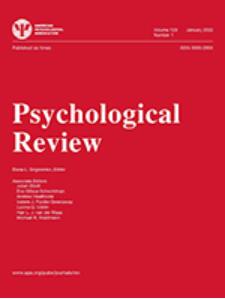视觉中有限的信息处理能力解释了数字心理物理学。
IF 5.1
1区 心理学
Q1 PSYCHOLOGY
引用次数: 0
摘要
人类和其他动物能够感知并表示场景中存在的大量物体,这种核心认知能力被认为是数学发展的基础。然而,人们对支撑这种能力的感知机制仍然知之甚少。在这里,我们展示了我们对数字的视觉感知来自于一个旨在有效编码场景中物体位置的视觉系统。通过数学模型,我们证明了高效但信息有限的物体位置编码可以解释数字心理物理学的许多关键方面,包括亚位化、韦伯定律、低估和曝光时间的影响。在两项实验(每项实验的人数均为 100 人)中,我们发现这种视觉编码模型可以捕捉到人类在变化定位任务和数字估计任务中的表现。在第三个实验中(N = 100),我们发现,无论是从整体表现还是从推断模型参数来看,变化定位表现的个体差异都能高度预测数字估计的差异,参与者在不同任务中的推断信息能力在数字上没有差异。因此,我们的研究结果表明,数字认知的关键心理物理特征并不是由单独的模块或数字特有的能力产生的,而是感知的较低水平限制的副产品。(PsycInfo Database Record (c) 2024 APA, 版权所有)。本文章由计算机程序翻译,如有差异,请以英文原文为准。
Limited information-processing capacity in vision explains number psychophysics.
Humans and other animals are able to perceive and represent a number of objects present in a scene, a core cognitive ability thought to underlie the development of mathematics. However, the perceptual mechanisms that underpin this capacity remain poorly understood. Here, we show that our visual sense of number derives from a visual system designed to efficiently encode the location of objects in scenes. Using a mathematical model, we demonstrate that an efficient but information-limited encoding of objects' locations can explain many key aspects of number psychophysics, including subitizing, Weber's law, underestimation, and effects of exposure time. In two experiments (N = 100 each), we find that this model of visual encoding captures human performance in both a change-localization task and a number estimation task. In a third experiment (N = 100), we find that individual differences in change-localization performance are highly predictive of differences in number estimation, both in terms of overall performance and inferred model parameters, with participants having numerically indistinguishable inferred information capacities across tasks. Our results therefore indicate that key psychophysical features of numerical cognition do not arise from separate modules or capacities specific to number, but rather as by-products of lower level constraints on perception. (PsycInfo Database Record (c) 2024 APA, all rights reserved).
求助全文
通过发布文献求助,成功后即可免费获取论文全文。
去求助
来源期刊

Psychological review
医学-心理学
CiteScore
9.70
自引率
5.60%
发文量
97
期刊介绍:
Psychological Review publishes articles that make important theoretical contributions to any area of scientific psychology, including systematic evaluation of alternative theories.
 求助内容:
求助内容: 应助结果提醒方式:
应助结果提醒方式:


